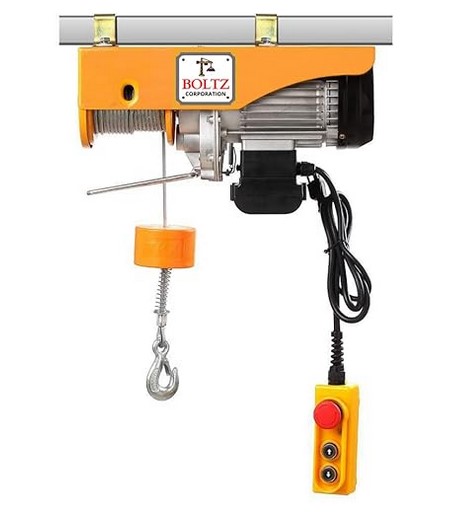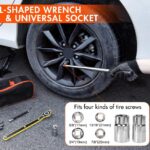An electric hoist is a mechanical device used for lifting and lowering loads vertically. It is powered by an electric motor and typically consists of a wire rope or chain that wraps around a drum or sheave. Electric hoists are designed to provide a safe and efficient means of moving heavy objects in various industrial and construction settings.
Electric hoists can be classified into different types based on their design and intended use. The most common types include:
- Wire Rope Hoists: These hoists use a wire rope as the lifting medium. They are available in various configurations, such as single-reeved, double-reeved, or triple-reeved, depending on the required lifting capacity and height.
- Chain Hoists: Instead of wire rope, chain hoists utilize a load chain as the lifting mechanism. They are often used for lower lifting heights and are known for their durability and precision.
- Lever Hoists: Also known as manual chain hoists, lever hoists rely on a hand-operated lever to lift and lower loads. They are typically used for lighter loads and in situations where electrical power is not available or desired.
The basic components of an electric hoist include an electric motor, gearbox, drum or sheave, wire rope or load chain, hook or load attachment, and a control system. The electric motor provides the power to rotate the drum or sheave, which in turn raises or lowers the load. The gearbox is used to reduce the motor speed and increase the torque, allowing for efficient lifting and lowering of heavy loads.
Table of Contents
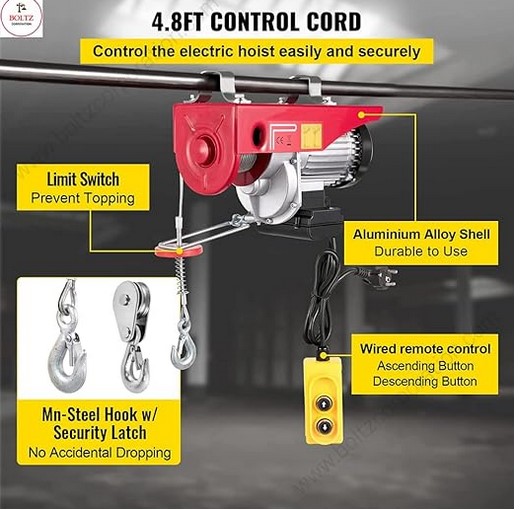
How Electric Hoists Work
Electric hoists are powered by an electric motor that drives a lifting mechanism to raise and lower loads. The operating principle involves converting electrical energy into mechanical energy through the motor, which then transfers the rotational motion to a system of gears, drums, or pulleys that control the lifting and lowering of the hook or load-carrying attachment.
The power source for electric hoists is typically a three-phase alternating current (AC) supply from the electrical grid or a portable power source, such as a generator. Some smaller hoists may also use single-phase AC or direct current (DC) power sources. The electric motor, which is the heart of the hoist, converts the electrical energy into rotational motion.
The lifting mechanism in electric hoists can vary depending on the specific design and application. One common mechanism is the drum-and-rope system, where the motor drives a drum around which the lifting rope or cable is wound. As the drum rotates, it winds or unwinds the rope, raising or lowering the load. Another mechanism is the chain-and-sprocket system, where the motor drives a sprocket that engages with a lifting chain, allowing the load to be lifted or lowered.
Additionally, some electric hoists employ a gearbox or gear reduction system to increase the torque and reduce the speed of the lifting mechanism, enabling them to lift heavier loads. The gearbox translates the high-speed, low-torque output of the motor into a low-speed, high-torque output suitable for lifting operations.
Applications of Electric Hoists
Electric hoists are versatile machines used in various industries for lifting and moving heavy loads. They find widespread applications in the following sectors:
Construction Industry: Electric hoists play a crucial role in construction sites, where they are used for lifting and positioning heavy materials such as steel beams, concrete slabs, and equipment. They facilitate the efficient movement of loads, improving productivity and safety on construction projects.
Manufacturing Facilities: In manufacturing plants, electric hoists are employed for material handling tasks, such as moving raw materials, finished products, and machinery. They are essential for maintaining efficient production lines and streamlining logistics within the facility.
Warehousing and Distribution Centers: Electric hoists are indispensable in warehouses and distribution centers, where they are used for loading and unloading trucks, stacking and retrieving goods from shelves, and moving pallets and containers. They help optimize material flow and enhance operational efficiency.
Automotive Industry: In automotive manufacturing plants, electric hoists are utilized for lifting and positioning vehicle components, engines, and other heavy parts during the assembly process. They contribute to streamlined production and improved ergonomics for workers.
Shipbuilding and Repair: Electric hoists are commonly used in shipyards and ship repair facilities for lifting and moving heavy equipment, machinery, and ship components. They facilitate the construction, maintenance, and repair of vessels of various sizes.
Mining and Quarrying: In mining and quarrying operations, electric hoists are employed for lifting and transporting heavy loads, such as rocks, ore, and equipment. They play a vital role in ensuring efficient and safe material handling in these rugged environments.
Electric hoists are also used in various other industries, such as the aerospace industry, entertainment and event production, and even in residential settings for moving heavy furniture or appliances. Their versatility and ability to handle heavy loads make them an essential tool across numerous applications.
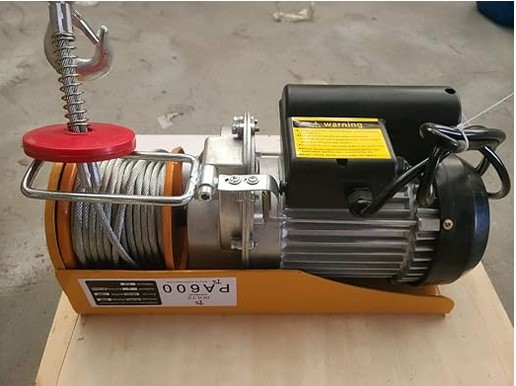
Benefits of Electric Hoists
Electric hoists offer several advantages over manual hoists, making them a preferred choice in various industries. One of the primary benefits is increased productivity. With electric hoists, heavy loads can be lifted and moved with minimal physical effort, allowing workers to complete tasks more efficiently and with less fatigue. This results in faster operations and higher output, ultimately boosting productivity.
Another significant advantage of electric hoists is improved safety. Unlike manual hoists, which require significant physical exertion and can lead to injuries from overexertion or improper lifting techniques, electric hoists minimize the risk of musculoskeletal disorders and reduce the potential for accidents caused by human error. Many electric hoists are equipped with advanced safety features, such as overload protection, emergency stop mechanisms, and braking systems, ensuring a high level of safety for both operators and bystanders.
Electric hoists also offer greater control and precision in load handling. With variable speed controls and precise positioning capabilities, operators can maneuver loads with accuracy, minimizing the risk of damage to materials or equipment. This level of control is particularly important in industries where precise handling is critical, such as manufacturing, construction, and aerospace.
Furthermore, electric hoists are often more energy-efficient than their manual counterparts, contributing to lower operating costs and a reduced environmental impact. They also require less maintenance, as there are fewer moving parts subject to wear and tear, resulting in longer service life and lower overall ownership costs.
Types of Electric Hoists
There are several types of electric hoists, each designed for specific applications and lifting requirements. The main categories are:
Wire Rope Hoists: These hoists use a wire rope to lift and lower loads. Wire rope hoists are versatile and can handle a wide range of lifting capacities, from light-duty to heavy-duty applications. They are commonly used in construction, manufacturing, and material handling industries.
Chain Hoists: As the name suggests, chain hoists use a load chain instead of a wire rope. They are typically more compact and lighter than wire rope hoists, making them ideal for use in confined spaces or when portability is a concern. Chain hoists are often used in automotive repair shops, maintenance facilities, and workshops.
Lug Hoists: Lug hoists, also known as lug-all hoists, are designed for lifting and positioning heavy loads, such as machinery or equipment. They feature a lug or hook at the bottom of the hoist, which allows for easy attachment to the load. Lug hoists are commonly found in industrial settings, shipyards, and power plants.
In addition to the type of lifting mechanism, electric hoists can be classified based on their lifting capacity. Light-duty hoists are designed for lifting loads up to a few tons, while heavy-duty hoists can handle loads ranging from several tons to hundreds of tons.
Portability is another factor that distinguishes electric hoists. Some hoists are designed to be stationary and mounted to a fixed structure, such as an overhead crane or a monorail system. Others are portable and can be moved from one location to another, making them ideal for job sites or temporary lifting applications.
Electric Hoist Components
Electric hoists consist of several key components that work together to lift and lower loads safely and efficiently. Here are the primary components:
Motor: The motor is the powerhouse of an electric hoist, providing the necessary torque and rotational force to drive the lifting mechanism. Electric motors are commonly used, ranging from single-phase to three-phase designs, depending on the hoist’s capacity and power requirements.
Gearbox: The gearbox is a crucial component that transmits the motor’s rotational force to the drum or sheave while providing the necessary gear reduction. This reduction allows the motor to operate at an optimal speed while providing the required torque to lift heavy loads. Gearboxes can be planetary, worm, or spur gear types, depending on the hoist design.
Drum/Sheave: The drum or sheave is the component around which the wire rope or chain is wound. As the motor rotates, the drum or sheave winds or unwinds the wire rope or chain, raising or lowering the load. Drums are typically used for wire rope hoists, while sheaves are used for chain hoists.
Hook: The hook is the attachment point where the load is connected to the hoist. Hooks are designed to withstand high loads and are typically made of forged steel or other high-strength materials. Safety latches or mousing devices are often incorporated to prevent accidental load disengagement.
Controls: Electric hoists are equipped with various controls that allow operators to safely and precisely manage the lifting and lowering operations. These controls can include push-button pendants, radio remote controls, or integrated control panels, depending on the hoist’s design and application.
Braking System: Braking systems are essential for ensuring safe and controlled load handling. Electric hoists typically employ multiple braking mechanisms, such as mechanical load brakes, motor brakes, and sometimes regenerative braking. These brakes provide reliable load control, prevent unintended load movement, and ensure safe operation in case of power failure or other emergencies.
Each component plays a crucial role in the overall performance, safety, and reliability of an electric hoist. Proper selection, installation, and maintenance of these components are essential for ensuring safe and efficient lifting operations.
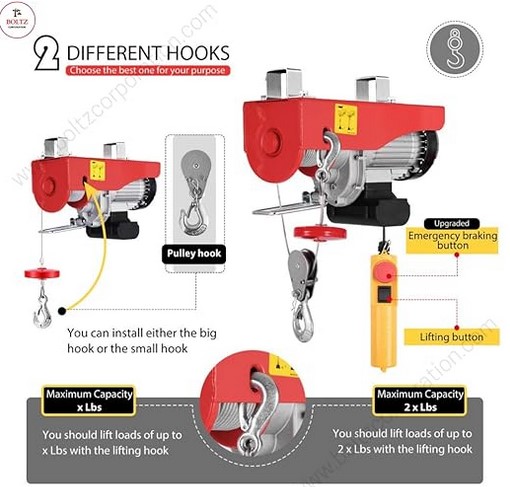
Choosing the Right Electric Hoist
Selecting the appropriate electric hoist for your application is crucial to ensure safe and efficient operations. Several factors need to be considered when choosing the right electric hoist, including:
Load Capacity: Determine the maximum weight you need to lift or move with the hoist. It’s essential to choose a hoist with a load capacity that exceeds your requirements to ensure safety and prevent overloading.
Headroom: Headroom refers to the vertical distance between the hook and the ceiling or overhead structure when the hook is at its highest position. Ensure that the available headroom in your facility is sufficient for the hoist’s operation.
Duty Cycle: The duty cycle refers to the amount of time the hoist can operate within a given period. Choose a hoist with a duty cycle that matches your operational requirements, whether it’s continuous, intermittent, or infrequent usage.
Lift Height: Consider the maximum lift height required for your application. Electric hoists are available in various lift heights, and selecting the appropriate one will ensure efficient operation and prevent unnecessary downtime.
Beam Capacity: If you plan to mount the hoist on an overhead beam, ensure that the beam’s capacity can support the combined weight of the hoist and the maximum load.
Environment: Evaluate the environmental conditions in which the hoist will operate. Some hoists are designed for harsh environments, such as high temperatures, corrosive atmospheres, or outdoor use, while others are better suited for indoor, clean environments.
Power Source: Electric hoists can be powered by different sources, including single-phase or three-phase electricity. Choose a hoist that matches the available power source in your facility.
Controls: Consider the type of control system you prefer, such as pendant controls, radio remote controls, or integrated controls. Choose a hoist with a control system that suits your operational needs and ensures ease of use.
Sizing Guidelines: Manufacturers provide sizing guidelines based on various factors, including load capacity, lift height, and duty cycle. Consult these guidelines to ensure you select the appropriate hoist size for your application.
By carefully considering these factors, you can choose an electric hoist that meets your specific requirements, ensuring safe and efficient material handling operations.
Installation and Maintenance
Proper installation of an electric hoist is crucial for ensuring safe and efficient operation. It’s recommended to follow the manufacturer’s instructions carefully and have the installation performed by trained professionals. Proper mounting and securing of the hoist to a suitable support structure is essential.
Regular maintenance is key to prolonging the lifespan of an electric hoist and preventing potential failures or accidents. Manufacturers typically provide a recommended maintenance schedule, which should be adhered to strictly. Common maintenance tasks include:
- Inspecting the wire rope or chain for wear, damage, or corrosion, and replacing if necessary.
- Checking the hook for deformation, cracks, or excessive wear, and replacing if needed.
- Lubricating moving parts, such as bearings and gears, according to the manufacturer’s recommendations.
- Inspecting the electrical components, including the motor, control panel, and wiring, for any signs of damage or wear.
- Verifying the proper functioning of safety devices, such as limit switches and brakes.
- Cleaning the hoist and removing any accumulated dirt, debris, or grease.
Common issues that may arise with electric hoists include:
- Wire rope or chain wear and damage, which can lead to failure and potential accidents.
- Bearing or gear wear, resulting in increased noise, vibration, and potential failure.
- Electrical component failure, such as motor burnout or control panel malfunction.
- Brake failure, which can cause uncontrolled load descent and serious safety hazards.
- Hook deformation or cracking, compromising the load-bearing capacity and safety.
Addressing these issues promptly through regular inspections and maintenance is crucial for ensuring the safe and reliable operation of an electric hoist.
Safety Precautions
Safety should be the top priority when operating electric hoists. Proper operator training, load testing, regular inspections, and adherence to safety standards are crucial to prevent accidents and ensure safe lifting operations.
Operator Training: Electric hoist operators must receive comprehensive training on the safe operation, inspection, and maintenance of the equipment. They should be familiar with the hoist’s load capacity, operating controls, and emergency procedures. Operators should also understand the importance of proper rigging techniques and the use of appropriate lifting accessories.
Load Testing: Before putting an electric hoist into service, it should undergo a load test to verify its lifting capacity and ensure proper functioning. Load tests should be performed by qualified personnel and in accordance with the manufacturer’s recommendations and applicable safety standards.
Inspection Requirements: Regular inspections are essential to identify and address any potential issues with the electric hoist. These inspections should cover the hoist’s components, including the wire rope, hooks, brakes, and electrical systems. Inspections should be performed by trained personnel, and any defects or wear should be addressed immediately to prevent equipment failure and potential accidents.
Safety Standards: Electric hoists must comply with relevant safety standards set by organizations such as the Occupational Safety and Health Administration (OSHA), the American Society of Mechanical Engineers (ASME), and the International Organization for Standardization (ISO). These standards provide guidelines for the design, manufacture, installation, operation, and maintenance of electric hoists, ensuring they meet minimum safety requirements.
By prioritizing operator training, load testing, regular inspections, and adherence to safety standards, businesses can minimize the risk of accidents and ensure the safe operation of electric hoists in their facilities.
Future of Electric Hoists
The future of electric hoists looks promising, with several emerging trends and technological advancements shaping the industry’s outlook. As the demand for efficient and sustainable material handling solutions continues to grow, manufacturers are investing in innovative technologies to enhance the performance, safety, and energy efficiency of electric hoists.
One of the significant trends is the integration of Internet of Things (IoT) technology into electric hoists. IoT-enabled hoists can collect and transmit real-time data on performance, maintenance needs, and operating conditions. This data can be analyzed to optimize maintenance schedules, improve operational efficiency, and reduce downtime. Additionally, remote monitoring and control capabilities enabled by IoT technology can enhance safety and productivity in industrial settings.
Another emerging trend is the development of intelligent control systems for electric hoists. These systems use advanced algorithms and sensors to monitor and adjust various parameters, such as load weight, speed, and positioning, ensuring precise and efficient operation. Intelligent control systems can also detect potential issues or anomalies, enabling predictive maintenance and reducing the risk of equipment failure.
The integration of renewable energy sources, such as solar panels or wind turbines, is also gaining traction in the electric hoist industry. These sustainable energy solutions can power electric hoists, reducing their carbon footprint and operating costs, while promoting environmental sustainability.
In terms of technological advancements, the use of lightweight yet strong materials, such as advanced composites and alloys, is expected to increase. These materials can reduce the overall weight of electric hoists, improving their portability and energy efficiency while maintaining their load-bearing capacity.
Furthermore, the development of wireless charging systems for electric hoists is an area of active research and development. Wireless charging can eliminate the need for physical connections, reducing maintenance requirements and increasing operational flexibility.
Looking ahead, the electric hoist industry is poised for growth, driven by the increasing demand for automation, efficiency, and sustainability in various sectors, including manufacturing, construction, and logistics. As technological innovations continue to emerge, electric hoists are expected to become more intelligent, energy-efficient, and user-friendly, providing safer and more productive material handling solutions for a wide range of applications.

